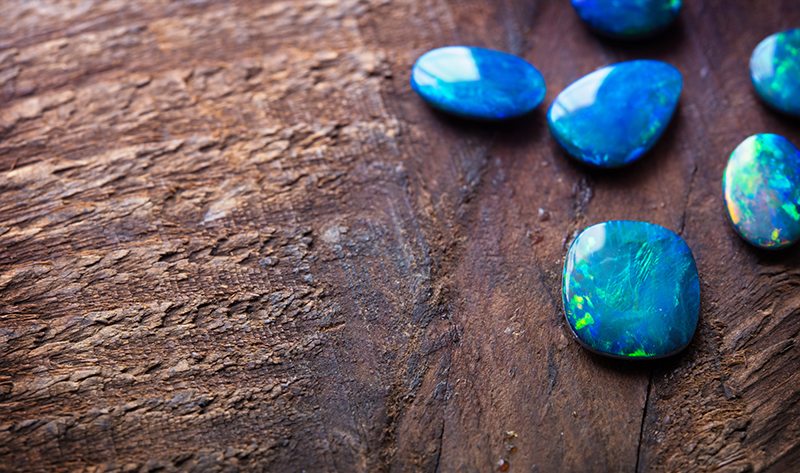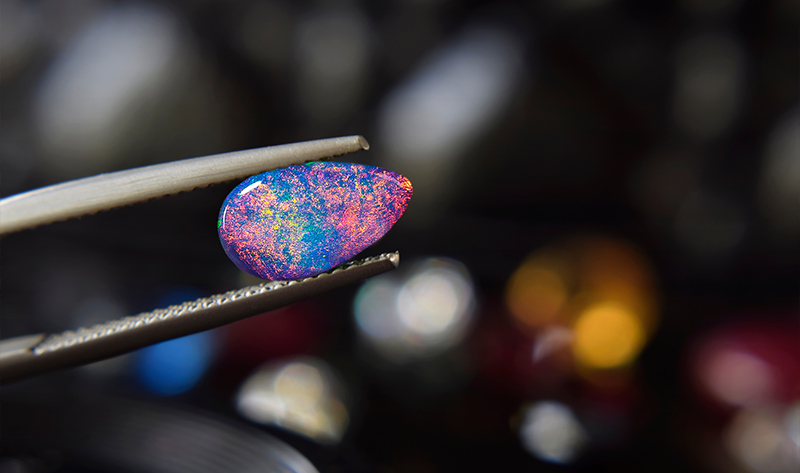Let’s be honest – Who doesn’t love a gorgeous blue opal? After all, not only is it absolutely eye-catching but it can also be paired with any outfit.
That said, have you ever stopped to wonder what makes this stone different from every other coloured opals? Because if so, we highly recommend reading on…
What Is Blue Opal Stone?

In a sentence, the blue opal gemstone is a variety of opal that comes in shades of blue and blue-green. In some cases, this term is used to describe a mostly opaque, teal-coloured variety of common opal found in the land of llamas and Machu Picchu.
Interestingly, this stone isn’t a mineral like the others. Nope, it’s a mineraloid. That essentially means it’s composed of microcrystalline silica spheres that scatter blue light like confetti at a New Year’s Eve party.
Now mind you, the blue opal stone isn’t just another pretty face in the world of gemstones – it’s all about that pizzazz!
You see, precious blue opals feature a spectacular play-of-colour that makes them the life of the gemstone party. On the other hand, common blue opals prefer to keep it subtle with an optical illusion called ‘adularescence.’ It’s like having an inner glow that says, “I’m fabulous, and I don’t need to show off on the surface.”
Also Read: Difference Between Opalite vs. Opal
Did You Know?
That the only other gems with adularescence are moonstone and, in certain cases, rose quartz.
When it comes to durability, natural blue opal ranks at a modest 5-6.5 on the Mohs scale of mineral hardness, putting it in league with turquoise and hematite.
Now, we know what you’re gonna ask, “Where in the world can I find these magnificent blue gems?” Well, if you’re a globe-trotting gem enthusiast, you’re in luck.
Peru and its neighbor, Brazil, are famous for the increasingly rare Paraiba opal – a bluish-green beauty that resembles the colour of sea glass. Slovakia and Indonesia also contribute to the worldwide symphony of blue opals. And if you’re feeling a bit more patriotic, the good old United States has some opal mines in Nevada, Idaho and Oregon.
Fun fact: Oregon’s Owyhee opals are a recent find and have a soothing palette of light to dark pastel blue.
The Story Behind Blue Opal’s Colour

Blue opals, like their flashy relatives, consist of microscopic hydrated silica spheres. The size and proximity of these tiny globules are what determine the colour we see when we gaze at these precious stones. It’s all about how light bounces through the crevices between these spheres.
So, why blue, you ask?
Well, the blue opal colour occurs when the spheres decide to be smaller. You see guys…bigger isn’t always better. *wink wink*
Sometimes though, nature throws a curveball and mineral inclusions also decide to contribute to that lovely blue hue. Take Peruvian opals for example. These beauties have secondary copper inclusions which result in an enchanting blue-green tint.
Also Read: Opal Vs Moonstone: What Will You Pick
Blue Opal History: Everything You Need to Know

Opal gemstones, in general, have a history that dates all the way back to 4000 BC. Archaeologists stumbled upon some opal action in a Kenyan cave and believed that the stones originated in Ethiopia.
Now, the name ‘opal’ has a few possible origins. One theory takes us to Sanskrit, where ‘upala’ means ‘precious stone.’ Another one leads us to ancient Greek and Latin with ‘opallios’ and ‘opallus,’ both of which essentially mean ‘to see a change in colour.’
In ancient Greece, opals were regarded as the ultimate oracle stone, believed to grant clairvoyant abilities. TBH, we kinda wish that was true. After all, who doesn’t want a gem that can predict traffic jams and weather disasters? The Greeks and Romans considered opals celestial gifts that warded off misfortune and illness. In Greek mythology, natural blue opals were considered to be Zeus’s tears of joy after defeating the Titans.
Ancient legends even suggested that opals fell from the heavens in flashes of lightning. Just imagine getting smacked on the head by a falling raw blue opal! Talk about a divine gem delivery service.
South America had its own take on blue opal stone myths. According to ancient beliefs, the gem was a gift from the Inca earth goddess, Pachamama. And let’s not forget the imaginative naming conventions. Ancient cultures were all about giving opals fancy titles like ‘Pandora’ or ‘The Eye Stone.’
Of course, if you thought Europe wasn’t present at this opalescent party, think again. Over the years, blue opals became symbols of innocence and hope. In some places, they were even symbolically placed within anchors in jewellery.
Lastly in the United States, many people believed that Owyhee blue opals had a hotline to the spirit realm, offering you guidance and strengthening your spiritual abilities. Move over, psychic hotline – we’ve got blue opal gemstones!
Blue Opal Symbolism: What Does the Stone Stand for Today?

In modern times, this type of opal symbolises healing, peacefulness, communication, freedom and creativity. Needless to say, this makes it a great gift for yourself or the one you love.
So, there you have it, the intriguing world of blue opals. It might not be the crown jewel of the gemstone kingdom, but it sure knows how to dazzle and mystify with its quirks. And isn’t that all you really need to steal the spotlight at every event?
Interested in other opals? cheque out our opal jewellery collection. Whether you’re looking to turn up the charm with an opal ring and pair of opal earrings or leave them speechless with an opal bracelet and opal necklace, our collection has several options for you to choose from. We also have multiple opal engagement ring and opal promise ring designs in our repertoire for a spectacular ‘Yes’ and ‘I Do.’




























